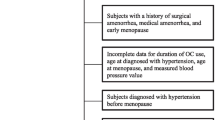Abstract
Blood pressure (BP) and body weight were assessed at entry, 6 months and 12 months of use in a prospective study of 117 and 76 women using low-dose oral contraceptives (LD-OCs) and NorplantR, respectively. The results showed that mean systolic BP (mmHg), diastolic BP (mmHg) and weight (kg) for LD-OCs and Norplant at entry, 6 months and 12 months, respectively, were not significantly different. During the one year of use, the study found that moderate increase in BP occurred at the same frequency as reduced BP, and that observed variation in BP was within a narrower range in Norplant users compared with LD-OC users.
Resumé
Lors d'une étude propective de 117 et 76 femmes qui utilisaient respectivement un contraceptif oral à faible dosage (CO-FD) et l'implant NorplantR, on a enregistré au début la pression sanguine et le poids corporel. Les résultats ont montré que la pression systolique moyenne (mmHg), la pression diastolique (mmHg) et le poids chez les utilisatrices de CO-FD et du Norplant au début, à 6 mois et à 12 mois n'étaient pas significativement différents. L'étude a en outre montré que, durant la première année d'utilisation, une légère élévation de la pression sanguine se produisait à la même fréquence qu'une baisse de cette pression, et on a observé que la variation de la pression sanguine restait dans une gamme plus étroite chez les utilisatrices du Norplant que chez celles qui faisaient appel aux contraceptifs CO-FD.
Resumen
En un estudio prospectivo de 117 y 76 mujeres que utilizaban respectivamente un anticonceptivo oral de dosis baja (AO-DB) y el implante NorplantR, se tomaron al principio la presión sanguínea y el peso corporal. Los resultados indicaron que la presión sistólica media (mmHg), la presión diastólica (mmHg) y el peso (kg) en las usuarias de AO-DB y del Norplant al principio, a los 6 meses y a los 12 meses no eran significativamente diferentes. El estudio demostró asimismo que, durante el primer año de uso, se producía un leve aumento de la presión sanguínea con la misma frecuencia que una disminución de la misma, y se observó que la variación de la presión sanguínea quedaba dentro de una gama más estrecha entre las usuarias de Norplant que entre las que utilizaban anticonceptivos AO-DB.
Similar content being viewed by others
References
MeadeT.W. (1988). Risks and mechanisms of cardiovascular events in users of oral contraceptives.Am. J. Obstet. Gynecol.,158, 1646–1651
BeaumontV. and BeaumontJ.L. (1989). The vascular risks of oral contraceptives—reality and mechanism. 1. Risk evaluation.Presse Med.,18, 1203–1206
SturtevantF.M. (1989). Special report: Safety of oral contraceptives related to steroid content: a critical review.Int. J. Fertil.,34, 323–332
Wharton, C. and Blackburn, R. (1988). Lower-dose pills.Population Rep., Series A, No. 7
FischI.R. and FrankJ. (1977). Oral contraceptives and blood pressure.J. Am. Med. Assoc.,237, 2499–2503
AlvarezF., BracheV., FaundesA., JohanssonE.D.B., OdlindV. and NashH. (1983). Levonorgestrel plasma levels during continuous administration with different models of subdermal implants.Contraception,27, 123–130
Liskin, L., Blackburn, R. and Ghani, R. (1987). Hormonal contraception: new long-acting methods.Population Rep., Series K, No. 3
DiazS., PavesM., MirandaP., RobertsonD.M., SivinI. and CroxattoH.B. (1982). A five-year clinical trial of levonorgestrel silastic implants (Norplant).Contraception,25, 447–456
TrusselJ. and KostK. (1987). Contraceptive failure in the United States: a critical review of the literature.Stud. Fam. Plann.,18, 237–283
TsaiC.C., WilliamsonH.O., KirklandB.H., BraunJ.O. and LamC.F. (1985). Low dose oral contraception and blood pressure in women with a past history of elevated blood pressure.Am. J. Obstet. Gynecol.,151, 28–32
FakeyeO. and BaloghS. (1989). Effect of Norplant contraceptive use on hemoglobin, packed cell volume and menstrual bleeding patterns.Contraception,39, 265–274
DeCetinaT.C., ReyesL.P., GamboaL.V., DunsonT.R., RowanA.J., WaszakC.S. and WeaverM.B. (1990). A comparative clinical trial of Norinyl 1+35 versus Norinyl 1+50 in Merida, Yucatan, Mexico.Adv. Contracept.,6, 125–139
Author information
Authors and Affiliations
Rights and permissions
About this article
Cite this article
Fakeye, O. The effect of low-dose oral contraceptives and Norplant on blood pressure and body weight of Nigerian women. Adv Contracept 8, 27–32 (1992). https://doi.org/10.1007/BF01849345
Received:
Accepted:
Issue Date:
DOI: https://doi.org/10.1007/BF01849345




